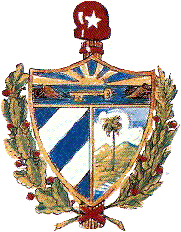History of Cuba

If you don't want to hear the music, Click below

A Venezuelan general, Narciso Lopez, made in 1848 the first serious attempt to help Cuba break away from Spanish rule.
He carried 'La Estrella Solitaria' -'The Lone Star'- flag, Cuba's present flag. (While he was having important meetings on the revolution, his wife embroidered it).
His attempt was not successful; only in 1902 Cuba became an independent republic and Lopez's flag was adopted as the official flag.
The three blue stripes are the symbols of the original three provinces. The triangle is a Masonic symbol, here signifying liberty, equality and fraternity. The red color is for the blood sacrificed by the Cuban patriots.
The year was 1849. It was a steamy hot day in New York City and General Narciso Lopez, of Venezuelan origin, had joined the fight for Cuba's independence. Exhausted from planning all that was entailed in bringing Revolution to Cuba, he sat a local park, and quickly fell asleep. He was concerned about the pending arrival in Cuba. He felt a flag was necessary to add patriotic fervor to the endeavor. When he awoke in the park, the colors of the splendorous sky allowed him to envision the would-be flag. Full of emotion, he went to his friend, a poet and soon-to-be patriot, Miguel Teurbe Tolón, who incorporated Narciso's ideas and designed the flag which was later sewn by Emilia Teurbe Tolón.
And so it was: Three light blue stripes, later changed to ocean blue, representing Cuba's three sections at the time, Western, Central and Eastern. The two white stripes representing the purity and justice of the patriotic liberators' motives. While the lone white star within the equilateral red triangle represents the unity of our people upon the blood spilled by our revolutionary heroes.

The coat of arm of CUBA was conceived in 1849 by Miguel Terbe Tolón; a Cuban patriot born in the west providence of Cuba known as Matanzas. General Narciso Lopez head of the Provincial Government of Cuba, adopted the coat of arm to seal communications and bonds emitted during the years of 1850 and 1851.
Originally the Cuban coat of arms contained elements that were later omitted for not being considered representative of the ideals of that time.
On April 21, 1906, Tomás Estrada Palma, (first constitutional president of Cuba) through a decree, determined how the second of the national symbols would come to be, one that through the annals of history, would always remind the glories of the past and the consecrations of grand efforts.
The coat of arms was shaped from an elongated oval, and is divided through two thirds of its height where it is then cut off by a horizontal line. In the upper part, the main area, one observes an ocean in which two landmasses are visible with a key placed at the center.
These elements symbolize the geographical importance and politics of CUBA. The key represents the entrance of the Gulf of Mexico and the significance of the land masses are from left to right, Cape Sable, Florida and Cape Catoche, Mexico. In the background, the sun appears partially sunk on the horizon, detonating its tropical heat.
The lower left quadrant, represent the division of the island, or the Departments in which the island was divided in those times, representing them with three turquoise stripes. Two white stripes, that exhibit the purity of its patriots, inserted between the three turquoise stripes, close the contents of the compartment.
In the lower right quadrant there is a palm tree, symbol of the health and fertility of its privileged ground, exposing that the palm has been the most utilized tree throughout the history of that country. The background displays two mountains and light silhouettes frame the landscape.
As a way of support, a column of rods shows at the top and bottom of the "ojiva" vertices. At the top is a cap with a five-point star. The column of rods means union of all Cubans; the star is the maximum expression of liberty.
The ornamentation of the coat of arms is finished, always visible from the front, and border from left to right a wreath of evergreen, which represents the peace, and another of laurel, that represents the victory, outlining the coat of arms.
The coat of arms, born in conjunction with the Republic, was ratified by the Constitution of 1940. Its original design, in debt to the patriot Miguel Teurbe Tolón, survived few modifications. It was Tolón, nourished by patriotic impulses, who designed a coat of arms to be taken to the forefront from a nobleman gesture in a bellicose attitude, and later in time to the premiere of the Republic.
 History of Cuba |
 The Ten Years' War |
 Independence War |
 José Martí |
 Antonio Maceo |
 Maximo Gomez |
 Calixto García Iñiguez |
 Carlos Manuel de Céspedes |
 Pagina Principal / Home |
![]() Top
Top
![]() juan@juanperez.com
juan@juanperez.com
Last time this page was edited April 19, 2015
@copyright 2015 Perez Professional Services all rights reserved
This page was created by Perez Professional Services (561) 313-6041